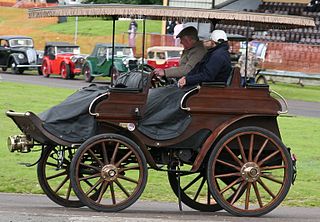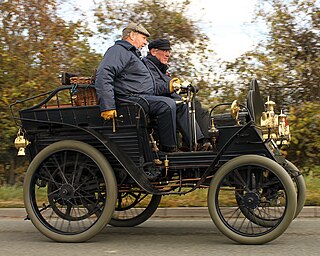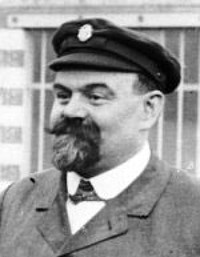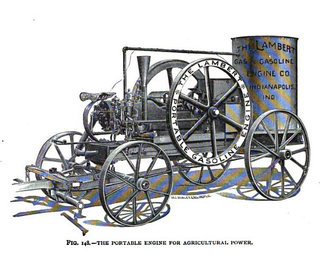
The Cadillac Motor Car Division is a division of the American automobile manufacturer General Motors Company (GM) that designs and builds luxury vehicles. Its major markets are the United States, Canada, and China. Cadillac models are distributed in 34 additional markets worldwide. Cadillac automobiles are at the top of the luxury field within the United States. In 2019, Cadillac sold 390,458 vehicles worldwide, a record for the brand.

The Brass Era is an American term for the early period of automotive manufacturing, named for the prominent brass fittings used during this time for such things as lights and radiators. It is generally considered to encompass 1896 through 1915, a time when these vehicles were often referred to as horseless carriages.

Arrol-Johnston was an early Scottish manufacturer of automobiles, which operated from 1895 to 1931 and produced the first automobile manufactured in Britain. The company also developed the world's first "off-road" vehicle for the Egyptian government, and another designed to travel on ice and snow for Ernest Shackleton's Nimrod Expedition to the South Pole.

L'Aster, Aster, Ateliers de Construction Mecanique l'Aster, was a French manufacturer of automobiles and the leading supplier of engines to other manufacturers from the late 1890s until circa 1910/12. Although primarily known as an engine mass manufacturer the company also produced chassis for coach-works and a complete range of components.

Wolseley Motors Limited was a British motor vehicle manufacturer founded in early 1901 by the Vickers armaments combine in conjunction with Herbert Austin. It initially made a full range, topped by large luxury cars, and dominated the market in the Edwardian era. The Vickers brothers died and, without their guidance, Wolseley expanded rapidly after the war, manufacturing 12,000 cars in 1921, and remained the biggest motor manufacturer in Britain.

The Mors automobile factory was an early French car manufacturer. It was one of the first to take part in automobile racing, beginning in 1897, due to the belief of the company founder, Émile Mors, in racing's technical and promotional benefits. By the turn of the century, automobile racing had become largely a contest between Mors and Panhard et Levassor.

Léon Bollée Automobiles was a French company founded by Léon Bollée in Le Mans to build a first vehicle called "Voiturette".

Lorraine-Dietrich was a French automobile and aircraft engine manufacturer from 1896 until 1935, created when railway locomotive manufacturer Société Lorraine des Anciens Etablissements de Dietrich et Cie de Lunéville branched into the manufacture of automobiles. The Franco-Prussian War divided the company's manufacturing capacity, one plant in Niederbronn-les-Bains, Alsace, the other in Lunéville, Lorraine.
The Garrard & Blumfield or Blumfield & Garrard was an English electric car manufacturer from 1894 to 1896. The company is presumed to have been founded by C. R. Garrard and T. W. Blumfield.

Léon Bollée was a French automobile manufacturer and inventor.

Charles Campbell Worthington, or C.C. Worthington, was an American industrialist whose efforts were in part responsible for the foundation of the Professional Golfers Association. He invented the first commercially successful gang lawnmower for fairway maintenance.

The Lambert Automobile Company was a 300,000-square-foot (28,000 m2) automobile factory in Anderson, Indiana to make the Lambert automobile through the Buckeye Manufacturing Company.
Detroit Auto Vehicle Company was a short-lived early automobile manufacturer established in the summer of 1904 with a capital stock of US$150,000. Based in Detroit in the old Detroit Novelty Machine Company building, it also had a foundry in Romeo, Michigan. It ceased operation in October 1907 following bankruptcy.

The Buckeye Manufacturing Company was a company originally formed to manufacture horse drawn buggy parts.

The Union Automobile Company began to make automobiles in Union City, Indiana in 1902. It built the Union automobile from 1902 through 1905. The company was located in Union City, Indiana from 1902 to 1905. In 1905 it moved to Anderson, Indiana.

The Lambert Gas and Gasoline Engine Company was a company founded by John William Lambert in the later part of the nineteenth century as part of the conglomerate of the Buckeye Manufacturing Company.

The Worthington Mower Company, originally called the Shawnee Mower Factory, produced lawn mowers and light-duty tractors in the United States from the early 1920s until around 1959. Founded by Charles Campbell Worthington and run as a family business, in 1945 it was purchased by Jacobsen Manufacturing. It continued to produce tractors and mowers in Stroudsburg, Pennsylvania, until around 1959.

Shawnee on Delaware is an unincorporated community on the Delaware River, part of Smithfield Township in Monroe County, Pennsylvania. It is situated just south of the foothills of the Pocono Mountains, 2.6 miles (4.2 km) southwest of the Shawnee Mountain Ski Area and about 75 miles (121 km) west of New York City.
Jacobsen Manufacturing produced lawn mowers and light-duty tractors in the United States from the early 1920s until around 1975. The name is still used by Textron

Iris was a British car brand that was manufactured from 1906-1925 by Legros & Knowles Ltd in Willesden, London and Aylesbury, Buckinghamshire.

















